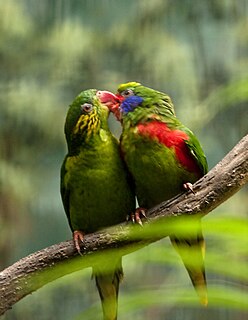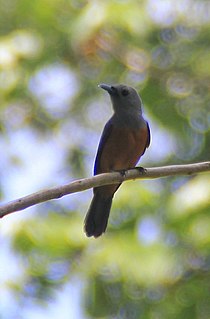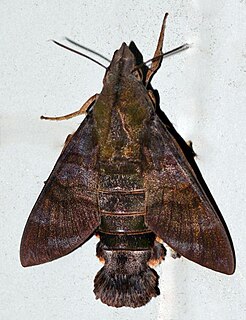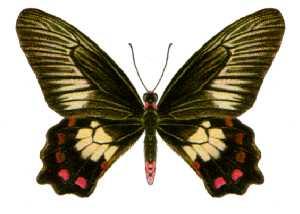
Milne Bay is a province of Papua New Guinea. Its capital is Alotau. The province covers 14,345 km² of land and 252,990 km² of sea, within the province there are more than 600 islands, about 160 of which are inhabited. The province has about 276,000 inhabitants, speaking about 48 languages, most of which belong to the Eastern Malayo-Polynesian branch of the Austronesian language family. Economically the province is dependent upon tourism, oil palm, and gold mining on Misima Island; in addition to these larger industries there are many small-scale village projects in cocoa and copra cultivation. The World War II Battle of Milne Bay took place in the province.
Albert Stewart Meek was an English bird collector and naturalist.

Papilio fuscus, the Canopus swallowtail, is a butterfly of the family Papilionidae, that is found on Timor, northern Australia, and New Guinea.

The Trobriand Islands rain forests are a tropical moist broadleaf forest ecoregion of southeastern Papua New Guinea.

The glossy swiftlet is a species of swift in the family Apodidae. It is found on the Indonesian island of Sulawesi and eastwards to New Guinea, the Bismarck Archipelago and the Solomon Islands.

The red-flanked lorikeet is a species of parrot in the family Psittaculidae. It is found in Mollucas, New Guinea and the Bismarck Archipelago. Its natural habitats are subtropical or tropical moist lowland forests and subtropical or tropical mangrove forests. Only the adult males have the red plumage on the head and sides.

The purple-bellied lory is a species of parrot in the family Psittaculidae. It is endemic to Papua New Guinea. It is found in south-east New Guinea, the Bismarck Archipelago, the d'Entrecasteaux Islands, the Louisiade Archipelago, the Trobriand Islands and Woodlark Island.

The island monarch is a species of bird in the family Monarchidae. It is found from Sulawesi to the Solomon Islands. Its natural habitats are subtropical or tropical moist lowland forests and subtropical or tropical moist montane forests.

The shining flycatcher is a species of bird in the family Monarchidae. It is found in northern Australia, and from the Moluccas to the Bismarck Archipelago. Its natural habitats are subtropical or tropical moist lowland forest and subtropical or tropical mangrove forest.

The Panniet naked-backed fruit bat, also known as the De Vis's Bare-backed Fruit Bat and Panaeati Bare-backed Fruit Bat, is a species of megabat in the family Pteropodidae. It roosts in groups, within caves and tree hollows.

Macroglossum corythus is a species of hawk moth of the family Sphingidae. It was described by Francis Walker in 1856 and is found throughout the Indo-Australian tropics east to New Caledonia.

Papilio euchenor is a butterfly of the family Papilionidae.

Pantoporia venilia, the Cape York aeroplane or black-eyed plane, is a butterfly of the family Nymphalidae. It is found in Australia (Queensland), Indonesia, Papua New Guinea and surrounding islands.

Pachliopta polydorus, the red-bodied swallowtail, is a butterfly from the family Papilionidae found in north-eastern Queensland, Australia as well as Papua New Guinea and New Zealand.

Hypolimnas alimena, the blue-banded eggfly, is a species of butterfly in the family Nymphalidae. It is found in the Solomon Islands, Indonesia, New Guinea and Australia.

Charaxes latona, the orange emperor, is a butterfly of the rajahs and nawabs group, i.e. the Charaxinae group of the brush-footed butterflies family. It is native to the tropical rainforests of eastern Indonesia, western Melanesia and far northern Queensland, Australia, where it is limited to the Iron Range.
Nyctemera evergista is a moth of the family Erebidae first described by Stoll in 1781. It is found on the Moluccas, Seram, Buru and in New Guinea.
Dolicholobium is a genus of flowering plants in the family Rubiaceae. The genus is found from central Malesia to the southwestern Pacific.

Danis danis, the large green-banded blue, is a species of butterfly in the family Lycaenidae. This species can be found in the Australia and New Guinea. Larva feed on Alphitonia excelsa.
Jean François Sylvestre Denis de Trobriand was a French naval officer and navigator who particularly distinguished himself during the expedition of d'Entrecasteaux to Australasia (1791–94). The Trobriand Islands in Papua New Guinea were named after him.

















